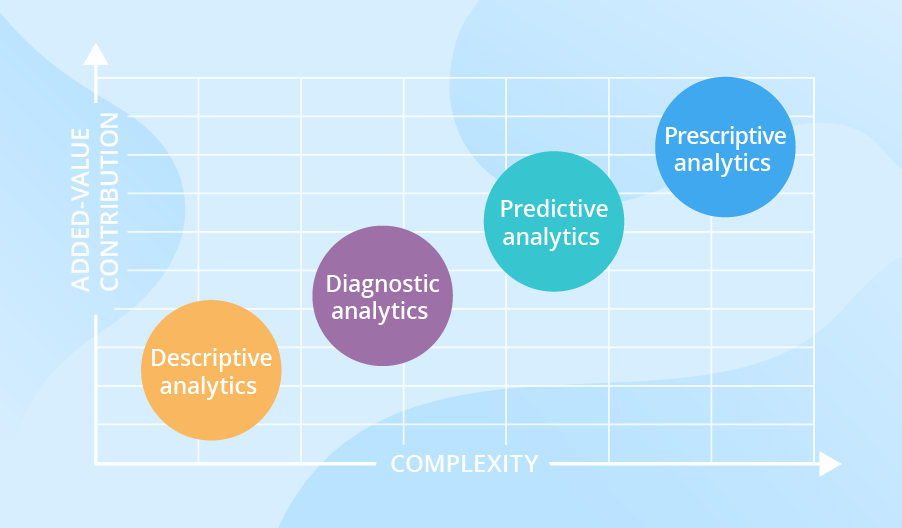4 Types of Data Analytics to Improve Decision-Making
Editor's note: If, despite all your efforts, your decision-making is still gut-feeling-based rather than informed, check whether you use the right mix of data analytics types. Read on and turn to our data analytics consultants for tailored recommendations.
Back in the 17th century, John Dryden wrote, “He who would search for pearls must dive below.” Although the author did not have advanced data analytics in mind, the quote perfectly describes its essence. Together with ScienceSoft, let’s find out how deep one should go into data in search of much-needed and fact-based insights.
Types of Data Analytics
There are 4 different types of analytics. Here, we start with the simplest one and go further to the more sophisticated types. As it happens, the more complex an analysis is, the more value it brings.

Descriptive analytics
Descriptive analytics answers the question of what happened. Let us bring an example from ScienceSoft’s practice: having analyzed monthly revenue and income per product group, and the total quantity of metal parts produced per month, a manufacturer was able to answer a series of ‘what happened’ questions and decide on focus product categories.
Descriptive analytics juggles raw data from multiple data sources to give valuable insights into the past. However, these findings simply signal that something is wrong or right, without explaining why. For this reason, our data consultants don’t recommend highly data-driven companies to settle for descriptive analytics only, they’d rather combine it with other types of data analytics.
Diagnostic analytics
At this stage, historical data can be measured against other data to answer the question of why something happened. For example, you can check ScienceSoft’s BI demo to see how a retailer can drill the sales and gross profit down to categories to find out why they missed their net profit target. Another flashback to our data analytics projects: in the healthcare industry, customer segmentation coupled with several filters applied (like diagnoses and prescribed medications) allowed identifying the influence of medications.
Diagnostic analytics gives in-depth insights into a particular problem. At the same time, a company should have detailed information at their disposal, otherwise, data collection may turn out to be individual for every issue and time-consuming.
Predictive analytics
Predictive analytics tells what is likely to happen. It uses the findings of descriptive and diagnostic analytics to detect clusters and exceptions, and to predict future trends, which makes it a valuable tool for forecasting. Check ScienceSoft’s case study to get details on how advanced data analytics allowed a leading FMCG company to predict what they could expect after changing brand positioning.
Predictive analytics belongs to advanced analytics types and brings many advantages like sophisticated analysis based on machine or deep learning and proactive approach that predictions enable. However, our data consultants state it clearly: forecasting is just an estimate, the accuracy of which highly depends on data quality and stability of the situation, so it requires careful treatment and continuous optimization.
Prescriptive analytics
The purpose of prescriptive analytics is to literally prescribe what action to take to eliminate a future problem or take full advantage of a promising trend. An example of prescriptive analytics from our project portfolio: a multinational company was able to identify opportunities for repeat purchases based on customer analytics and sales history.
Prescriptive analytics uses advanced tools and technologies, like machine learning, business rules and algorithms, which makes it sophisticated to implement and manage. Besides, this state-of-the-art type of data analytics requires not only historical internal data but also external information due to the nature of algorithms it’s based on. That is why, before deciding to adopt prescriptive analytics, ScienceSoft strongly recommends weighing the required efforts against an expected added value.
4 Types of Analytics at a Glance + Sample Implementation Costs
| Descriptive analytics | Diagnostic analytics | Predictive analytics | Prescriptive analytics | |
| Purpose | Learn what happened. | Learn why something happened. | Learn what is likely to happen. | Learn what to do. |
| Output | Static reports with KPIs. | Reports with drill-down, slicing, and dicing capabilities. | Forecasts. | Actionable recommendations. |
| Examples | Sales volume for the last month. | Why sales volume was below the target. | The projected sales volume for the next month. | A recommendation on how to increase sales volume, e.g., by adjusting loyalty policies. |
|
Implementation costs The lower bracket covers 2–5 data sources and batch data processing. The upper bracket covers up to 15 data sources and real-time data processing. |
$50,000–$150,000 |
$30,000–$250,000 (if added on top of descriptive analytics) |
$30,000– $150,000 (if added on top of descriptive analytics) |
$150,000–$300,000 (if added on top of descriptive, diagnostics and predictive analytics) |
What Types of Data Analytics Do Companies Choose?
Wavestone Data and AI Leadership Executive Survey indicates that 87.9% of participants view investment in data analytics as a top organizational priority, and 62.3% place the same emphasis on AI-related investments. The market situation confirms the trend: Fortune Business Insights says that data analytics market will reach $402.70 billion by 2032.
According to Fortune Business Insights, predictive analytics dominates the market among other analytics types. The popularity stems from the recent advancements in ML/AI techs that make it possible to build models for highly accurate forecasts.
The Global Data Insights Survey by Digital Reality reveals that more than 50% of organizations bet on data-driven insights to develop new products and services, improve customer satisfaction and experience, and mitigate risks and cybersecurity breaches. As for AI, businesses believe that the technology will be useful for improving customer experience, enhancing the efficiency of business operations, and creating a competitive advantage.
Regarding the challenges businesses face in analytics, the Global Leadership Survey by Clootrack says that 24% struggle with efficient data integration, 21% face a skill gap, 20% lack real-time analytics tools, and 18% find it problematic to transform data into insights. The above survey by Digital Reality sheds light on why drawing insights from data can be challenging: between 43% and 52% of data and AI leaders attribute the difficulties to insufficient investment into data analytics tools and infrastructure, customer reluctance to share data, and data silos.
How AI Is Used in Data Analytics
The advancements in ML/AI techs have reached many business realms, and data analytics is no exception. According to Forrester, 63% of data and analytics leaders believe they make faster and better decisions by applying AI/ML to their data. Let’s consider a few use cases to see how exactly AI can enhance data analytics.
Automating data processing and preparation
No matter what type of analytics a company uses, it should first ingest, clean, and transform raw data. AI can automate many of these tasks. For example, AI algorithms can identify missing values, outliers, duplicates, and other inconsistencies in raw data and correct them. There can also be mechanisms for converting multi-source data into consistent formats and extracting structured data from unstructured documents.
Enhancing predictive and prescriptive analytics
With the rise of GenAI, predictive and prescriptive models have gained higher accuracy, as they can analyze more complex, non-linear relationships and dynamically adjust to changing variables. Modern models can also deal with enormous datasets in a short time, which enables them to perform simulations with thousands of variables, giving users a broad view of possible outcomes.
Another boost that GenAI has given to traditional predictive and prescriptive models is the ability to generate synthetic data, which is especially valuable when there is not enough real-world data to train an accurate model.
Democratizing data analytics
Many BI and analytics solutions now have natural language interfaces. Users can just type in a description of the report or insight they need and get it in the required form, be it a graph, chart, table, or plain text. You can see how such solutions work in practice by navigating to our demo of a Power BI chatbot integrated with a corporate MS Teams app. Such an approach helps save time and promotes the adoption of analytics among users who have no skills in coding or SQL querying.
What Types of Data Analytics Does Your Business Need?
To define the right mix of data analytics types for your organization, we recommend answering the following questions:
- What’s the current state of data analytics in my company?
- How deep do I need to dive into the data? Are the answers to my problems obvious?
- How far are my current data insights from the insights I need?
The answers to these questions will help you settle on a data analytics strategy. Ideally, the strategy should allow incrementally implementing the analytics types, from the simplest to more advanced. The next step would be to design the data analytics solution with the optimal technology stack, and a detailed roadmap to implement and launch it successfully.
You may try to complete all these tasks with the efforts of an in-house team. In this case, you’ll need to find and train highly qualified data analytics specialists, which will most probably turn lengthy and pricey. To maximize the ROI from implementing data analytics in your organization, we advise you to turn to an experienced data analytics provider with a background in your industry. A mature vendor will share the best practices and take care of everything, from the analysis of your current data analytics state and selection of the right mix of data analytics to bringing the technical solution to life. If the described approach resonates with you, our data analytics services are at your disposal.

